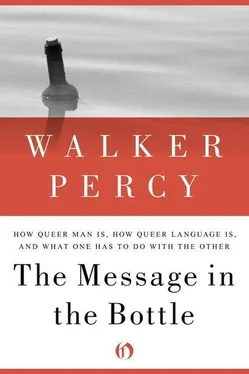But a second event occurred. One day Helen learned in great excitement that the word water spelled in one hand was the name of the liquid flowing over the other hand. She then wanted to know the names of other things.
Theorists of language behavior have been unable to give a coherent account of this event. When one tries to fit this triadic event onto a dyadic model, queer things happen. Ogden and Richards, for example, found themselves with a triangle, two sides of which represented proper “causal” relations between symbol and reference and between reference and referent. A dotted line was drawn between symbol and referent. The dotted line stood for an “imputed relation” between word and thing as contrasted with the “real” relation between word and organism, and organism and referent. The next step was to see man’s use of symbols as somehow deplorable. Korzybski constructed a curious quasi-ethical science of “general semantics” in which he berated people for the wrong use of symbols. Stuart Chase compared symbol-using man unfavorably with his cat Hobie.
One might suppose that a science of language behavior must first determine what sort of behavior is taking place before issuing moral judgments about it.
Three men have a toothache.
One man groans.
The second man say, “Ouch!”
The third man says, “My tooth aches.”
Now it may be unexceptionable to say that all three men emitted responses, the first a wired-in response, the second and third learned responses.* But if one wishes to give a nontrivial account of language behavior, it does not suffice to describe the second and third utterances as learned responses. What kind of a learned response is a sentence and how does it differ from other responses?
Nor does it suffice to describe the two events in Helen Keller’s childhood as instances of learning by reinforcement.
The greatest obstacle to progress in semiotic has been the loose use of analogical terms to describe different events without specifying wherein lies the similarity and wherein lies the difference. To use a term like response analogically is to risk a spurious understanding of matters that are in fact little understood and difficult to investigate.
One recalls Chomsky’s reaction to Skinner’s Verbal Behavior :
Anyone who seriously approaches the study of linguistic behavior, whether linguist, psychologist, or philosopher, must quickly become aware of the enormous difficulty of stating a problem which will define the area of his investigation, and which will not be either trivial or hopelessly beyond the range of present-day understanding and technique.
The following is a loose set of postulates and definitions which I take to be suitable for a behavioral schema of symbol use and which might be adapted from Peirce’s theory of triads. Recognizing the peculiar difficulties that regularly attend such enterprises — not the least source of confusion is the fact that unlike any other field of inquiry language is fair game for everybody, for formal and factual scientists, for logicians, linguists, learning theorists, semanticists, syntacticians, information theorists, and, alas, even for philosophers — I accordingly offer these propositions with the minimal expectation that they will at least suggest an alternative, a way of thinking about man’s use of signs which is different from the standard treatment and, I trust also, less dispiriting.
The Peirce scholar will note certain omissions and divergencies. There are two main departures from Peirce’s theory. (1) No account whatever is given here of Peirce’s ontology of Firstness, Secondness, and Thirdness in terms of which his semiotic is expressed. This omission I take to be justified by the desirability of using only those concepts which have operational significance for behavioral science. Accordingly, what is offered is not a comprehensive theory of signs but only a very tentative account of sentence utterance, that is, sentences considered as items of behavior. (2) The emphasis is clinical, that is, upon mistakes , misperceptions of sentences in their transmission from sender to receiver. There are two reasons for this emphasis. One is that the clinical encounter, that of therapist and patient, is the recurring paradigm in this essay. The other is that mistakes suggest a useful method of exploring this treacherous terrain. There are different kinds of mistakes and there are different kinds of variables in the communication process. Perhaps one may be taken as evidence of the other. A good way to study auto mechanics is to study auto breakdowns. Vapor locks, short circuits, transmission failures may be the best evidence that there are such things as carburetors, electrical systems, and gears — especially if the mechanic can’t lift the hood.
1. The basic unit of language behavior is the sentence.
A word has no meaning except as part of a sentence. Single-word utterances are either understood as sentences or else they are not understood at all. For example, when Wittgenstein’s Worker A says to Worker B, “Slabs!” Worker B understands him to mean, send slabs! — or perhaps misunderstands him to mean, I already have slabs.
If I say the word pickle to you, you must either understand the utterance as a sentence — this is a pickle, this is a picture of a pickle, pass the pickles, tastes like a pickle — or you will ask me what I mean or perhaps say, “What about pickles?”
1.1. A sentence utterance is a coupling of elements by a coupler.
The subject-predicate division* is not the only kind of coupling which occurs in sentences.* Not only can symbols be coupled with symbols; symbols can also be coupled with things or classes of things. Peirce’s example: A father catches his child’s eye, points to an object, and says, “Balloon.”
1.2. A sentence utterance is a triadic event involving a coupler and the two elements of the uttered sentence.†
1.21. If a dyadic relation is abstracted from a triadic relation and studied as such, the study may have validity as a science, but the science will not be a science of triadic behavior.
For example, a neurologist may study the dyadic events which occur in the acoustic nerve of a person who hears the sentence The King of France is bald. The result of such a study may be a contribution to the science of neurology, but it will not be a contribution to the science of triadic behavior.
A logician may abstract from the speaker of a sentence, study the formal relation between the terms of the sentence and what is entailed by its assertion. His study may contribute to the science of logic, but it will not contribute to the science of triadic behavior.
A professor writes a sentence on the blackboard: The King of France is bald. The class reads the sentence.
If one wishes to study this sentence utterance as an item of behavior, it does not suffice to abstract from the professor and the class and to study the semantics and syntax of the sentence. If one considers the sentence utterance as an item of behavior, one quickly perceives that it is a pseudo sentence. The sentence may have been uttered but it does not assert anything. For one thing, the phrase the King of France does not refer to anything, since there does not presently exist a king of France. For another thing, a second condition of bona fide sentence utterance is lacking. As Peirce said, asserting a sentence is something like going before a notary and assuming responsibility for it. No one imagines that the professor has done this.
Many of the philosophical puzzles about sentences have arisen from the failure to distinguish between actual sentence utterances and professors uttering pseudo sentences in classrooms.
1.3. A name is a class of sounds coupled with a thing or class of things.
Читать дальше












